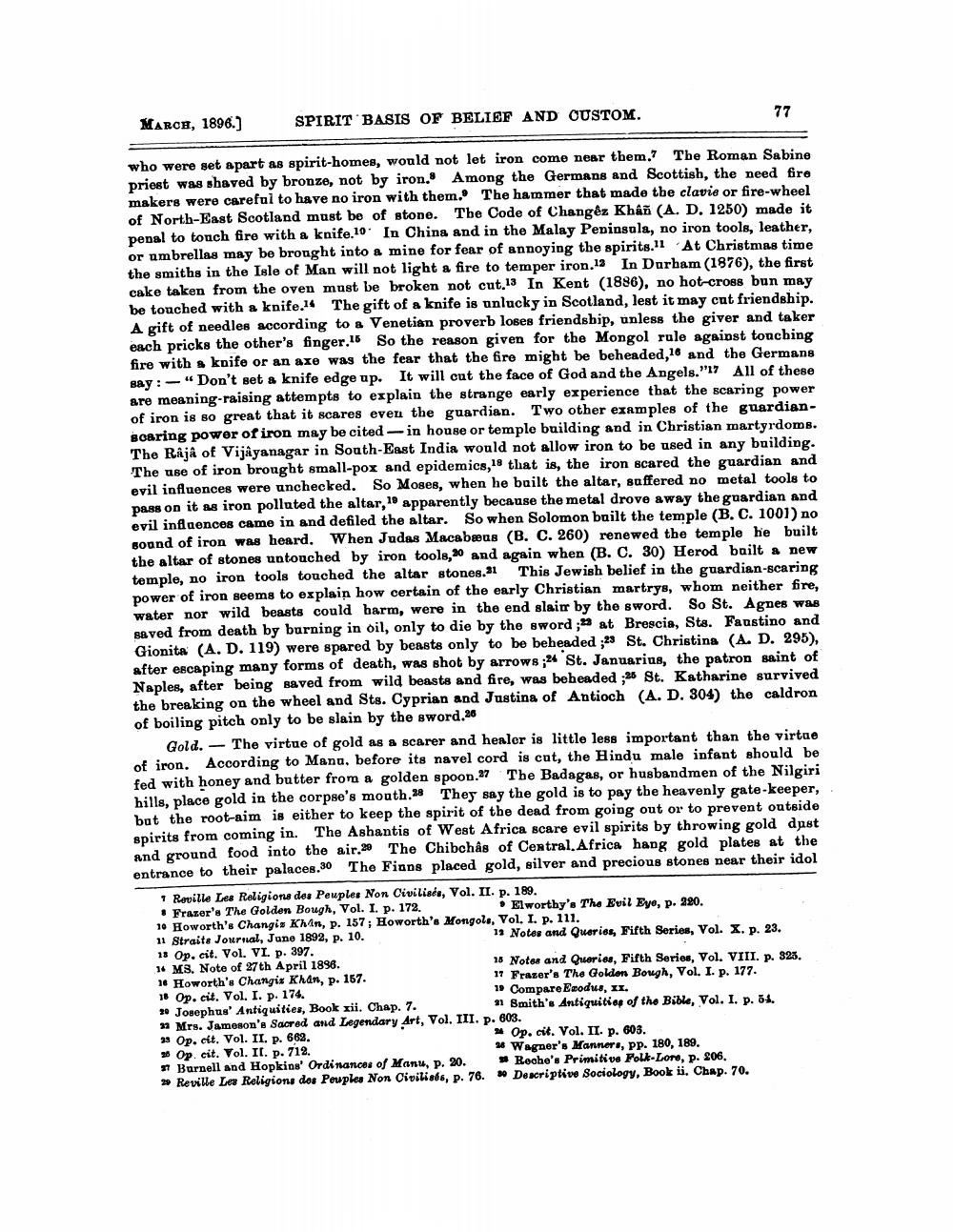________________
MARCH, 1896.)
SPIRIT BASIS OF BELIEF AND CUSTOM.
77
who were set apart as spirit-homes, would not let iron come near them. The Roman Sabine priest was shaved by bronze, not by iron. Among the Germans and Scottish, the need fire makers were careful to have no iron with them. The hammer that made the clavie or fire-wheel of North-East Scotland must be of stone. The Code of Changez Kháñ (A. D. 1250) made it penal to tonch fire with a knife.10. In China and in the Malay Peninsula, no iron tools, leather, or ambrellas may be brought into a mine for fear of annoying the spirits. At Christmas time the smiths in the Isle of Man will not light a fire to temper iron.13 In Durham (1876), the first cake taken from the oven must be broken not cut.13 In Kent (1886), no hot-cross bun may be touched with a knife.14 The gift of a knife is unlucky in Scotland, lest it may cut friendship. A gift of needles according to a Venetian proverb loses friendship, unless the giver and taker each pricks the other's finger,15 So the reason given for the Mongol rule against touching fire with a knife or an axe was the fear that the fire might be beheaded, 16 and the Germans say: -"Don't set a knife edge up. It will cut the face of God and the Angels."17 All of these are meaning-raising attempts to explain the strange early experience that the scaring power of iron is so great that it scares even the guardian. Two other examples of the guardianBoaring power of iron may be cited - in house or temple building and in Christian martyrdoms. The Raja of Vijayanagar in South-East India would not allow iron to be used in any building. The use of iron brought small-pox and epidemics, 18 that is, the iron scared the guardian and evil influences were unchecked. So Moses, when he bailt the altar, saffered no metal tools to pass on it as iron polluted the altar, 18 apparently because the metal drove away the guardian and evil influences came in and defiled the altar. So when Solomon built the temple (B. C. 1001) no sound of iron was heard. When Judas Macabæus (B. C. 260) renewed the temple he built the altar of stones untouched by iron tools, 20 and again when (B. C. 30) Herod built a new temple, no iron tools touched the altar stones.31 This Jewish belief in the guardian-scaring power of iron seems to explain how certain of the early Christian martrys, whom neither fire, water nor wild beasts could harm, were in the end slaitr by the sword. So St. Agnes was saved from death by burning in oil, only to die by the sword;at Brescia, Sta. Faustino and Gionita (A. D. 119) were spared by beasts only to be beheaded :23 St. Christina (A. D. 295), after escaping many forms of death, was shot by arrows;24 St. Januarius, the patron saint of Naples, after being saved from wild beasts and fire, was beheaded : 26 st. Katharine survived the breaking on the wheel and Sts. Cyprian and Justina of Antioch (A. D. 304) the caldron of boiling pitch only to be slain by the sword.26
Gold. - The virtue of gold as a scarer and healer is little less important than the virtae of iron. According to Manu, before its navel cord is cut, the Hindu male infant should be fed with honey and butter from a golden spoon.27 The Badagas, or husbandmen of the Nilgiri hills, place gold in the corpse's mouth.28 They say the gold is to pay the heavenly gate-keeper, but the root-aim is either to keep the spirit of the dead from going out or to prevent outside spirits from coming in. The Ashantis of West Africa scare evil spirits by throwing gold dust and ground food into the air.20 The Chibchâs of Central Africa hang gold plates at the entrance to their palaces.30 The Finns placed gold, silver and precious stones near their idol
1 Reville Les Religions des Peuples Non Civilisés, Vol. II. p. 189. • Frazer's The Golden Bough, Vol. I. p. 172
Elworthy's The Evil Eye, p. 220. 10 Howorth's Changis Khan, p. 157; Howorth's Mongola, Vol. I. p. 111. 11 Straits Journal, June 1892, p. 10.
11 Notes and Querios, Fifth Series, Vol. X. p. 23. 18 Op. cit. Vol. VI. p. 397. 16 MS. Note of 27th April 1898.
16 Notes and Queries, Fifth Series, Vol. VIII. p. 323. 16 Howorth's Changis Khan, p. 167.
11 Frazer's The Golden Bough, Vol. I. p. 177. 18 Op. cit. Vol. I. p. 174.
Compare Exodus, II. 20 Josephus' Antiquities, Book xii. Chap. 7.
* Smith's Antiquition of the Bible, Vol. I. p. 54. * Mrs. Jameson's Sacred and Legendary Art, Vol. III. p. 603. 93 Op. cit. Vol. II. p. 662.
Op. cit. Vol. II. p. 603. * Op. cit. Vol. II. p. 712.
46 Wagner's Manners, pp. 180, 189. 17 Burnell and Hopkins' Ordinances of Manu, p. 20. Rooho's Primitive Folk-Loro, p. 906. » Reville La Religione dos Peuple. Non Civilisés, p. 76. Descriptive Sociology, Book ii. Chap. 70.




